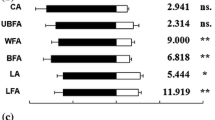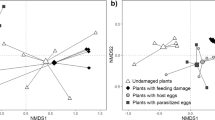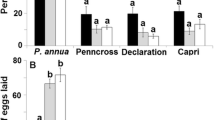Abstract
The egg parasitoid Anagrus nigriventris Girault is an important natural enemy of the beet leafhopper, Circulifer tenellus (Baker) which has a broad host range that includes cultivated sugar beets and the weed, Russian thistle. When parasitoids were reared on leafhopper eggs deposited in sugar beets, females were attracted to sugar beet volatiles and preferred them over a blank control and over Russian thistle volatiles in Y- tube olfactometer tests. No preference was detected for either plant by female wasps that were reared on Russian thistle. Wasps reared on Russian thistle and allowed an oviposition experience on sugar beet showed a strong attraction to sugar beet volatiles; however, wasps reared on sugar beets and allowed oviposition experience on Russian thistle demonstrated no preference between the two plants. The implications of parasitoid response towards plant volatiles and their importance in biological control are discussed.
Résumé
Le parasitoÏde oophageAnagrus nigriventris est un ennemi naturel important de la cicadelleCirculifer tenellus qui a une large gamme de plantes hÔtes comprenant aussi bien la betterave sucrière que des plantes sauvages commeSalsola tragus L. Lorsque les parasitoÏdes sont élevés sur des oeufs de cicadelles pondus dans des betteraves sucrières, les femelles sont attirées par les composés volatiles de la betterave et les préfèrent au témoin neutre ou aux composés deSalsola lors des tests en olfactomètre (tube en Y). On ne note aucune préférence pour l’une ou l’autre plante dans le cas de femelles élévées surS. tragus. Ces dernières qui ont une expérience de ponte sur betterave montrent par la suite une forte attraction pour les composés volatiles deS. tragus; cependant les parasitoÏdes élevés sur betterave et qui font l’expérience de ponte surS. tragus ne montrent aucune préférence entre les deux plantes. Les implications des réponses de ces parasitoÏdes vis-à-vis des composés volatiles issus de plantes et leur importance dans la lutte biologique sont discutées.
Similar content being viewed by others
References
Arthur, A. - 1962. Influence of host tree on abundance ofItoplectis conquisitor (Say), a polypha- gous parasite of the European shoot moth,Rhyactonia buoliana (Schiff.) -Can. Entomol.,94, 337–347.
Ball, E. D. - 1934. The number of generations of the beet leafhopper under natural conditions. -J. Econ. Entomol.,28, 945–959.
Chantarasa-ard, S., Hirashima, Y. &Hirao, J. - 1984. Host range and host suitability ofAnagrus incarnants Haliday (Hymenoptera: Mymaridae), an egg parasitoid of delphacid planthoppers. -Appl. Entomol. Zool.,19, 491–497.
Chiappini, E., Triapitsyn, S. V. &Donev, A. -1966. Key to the Holarctic species ofAnagrus Haliday (Hymenoptera: Mymaridae) with a review of the Nearctic and Palearctic (other than European) species with descriptions of new taxa. -J. Nat. Hist.,30, 551–595.
Cortesero, A. M. &Monge, J. P. -1994. Influence of pre-emergence experience on response to host and host plant odours in the larval parasitoidEupelmus vuilleti. -Entomol. Exp. Appl.,72, 281–288.
Eller, F. J., lumlinson, J. H. &Lewis, W. J. - 1992. Effect of host diet and preflight experience on the flight responses ofMicroplitis croceipes (Cresson). -Physiol. Entomol,17, 235–240.
Flock, R. A. - 1962. A survey of beet leafhopper egg parasites in the Imperial Valley. -J. Econ. Entomol,55, 277–281.
Franklin, R. T. &Holdaway, I. G. - 1966. A relationship of the plant to parasitism of European corn borer by the tachinid parasiteLydella grisescens. -J. Econ Entomol.,59, 440–441.
Rester, K. M., &Barbosa, P. -1991. Post emergence learning in the insect parasitoidCotesia congregata (Say) (Hymenoptera: Braconidae). -J. Insect Behav.,4, 727–742.
Jansson, R. K., &Lashomb, J. H. -1988. Host-habitat conditioning in the eulophid egg parasitoid,Edovum puttleri: effects of herbivore’s host and its food plant. -Entomol. Exp. Appl.,46, 173–180.
Kaiser, L., Pham-Delegue, M. H. &Masson, C. -1989. Olfactory responses ofTrichogramma maidis Pint, et Voeg.: effects of chemical cues and behavioral plasticity. -J. Insect Behav.,2, 701–712.
Meyerdirk, D. E. &Hessein, N. A. - 1985. Population dynamics of the beet leaf hopper,Circulifer tenellus (Baker), and associatedEmpoasca spp. (Homoptera: Cicadellidae) and their egg parasitoids on sugar beets in southern California. -J. Econ. Entomol,78, 346–353.
Meyerdirk, D. E. &Moratorio, M. S. - 1987a. Biology ofAnagrus nigriventris Crawford (Hymenoptera: Mymaridae), an egg parasitoid of the beet leafhopper,Circulifer tenellus (Ho- moptera: Cicadellidae). -Ann. Entomol Soc. Am.,80, 272- 277.
Meyerdirk, D. E. &Moratorio, M. S. - 1987b. Seasonal population density ofAnagrus nigriven- tris (Hymenoptera: Mymaridae), an egg parasitoid ofCirculifer tenellus andEmpoasca spp. (Homoptera: Cicadellidae). -J. Econ. Entomol.,80, 362–365.
Moratorio, M. S. - 1990. Host finding and oviposition behavior ofAnagrus mutons andA. silwoodensis (Hymenoptera: Mymaridae). -Environ. Entomol,19, 142- 147.
Miklasiewicz, T. J. - 1988. Investigations of the influence of high temperature on biological control of the woolly whitefly. M.S. thesis, University of California, Riverside.
Munger, F. - 1942. A method for rearing citrus thrips in the laboratory. -J. Econ. Entomol,35, 373–375.
Nordlund, D. A., Chalfant, R. B. &Lewis, W. J. - 1984. Arthropod populations, yield and damage in monocultures and polycultures of corn, beans and tomatoes.Agric. Ecosystems Environ.,11, 353–367.
Nordlund, D. A., Chalfant, R. B. &Lewis, W. J. - 1985a. Response ofTrichogramma pretiosum females to volatile synomones from tomato plants. -J. Entomol Sci.,20, 372–376.
Nordlund, D. A., Chalfant, R. B. &Lewis, W. J., - 1985b. Response ofTrichogramma pretiosum females to extracts of two plants attacked byHeliothis zea. -Agric. Ecosystems Environ.,12, 127–133.
Price, P. W., Bonton, C. E., Gross, P., McPheron, B. A., Thompson J. N. &Weiss, A. E. - 1980. Interactions among three trophic levels: Influence of plants on interactions between insect herbi- vores and natural enemies.Annu. Rev. Ecol Syst.,11, 41–65.
Severin, H. H. P. - 1924. Natural enemies of beet leafhopper(Eutettix tenellus Baker). -J. Econ. Entomol,17, 369–377.
Severin, H. H. P. -1930. Life history of beet leaf hopper,Eutettix tenellus (Baker) University of California Publications in Entomology. 5: 37–88.
Severin, H. H. P. &Henderson C. F. -1928. Some host plants of curly top. -Hilgardia,3, 339–384.
Stilling, P D. -1980. Host plant specificity, oviposition behaviour and egg parasitism in some leafhoppers of the genusEupteryx (Hemiptera: Cicadellidae). -J. Ecol Entomol,5, 79–85.
Thorpe, W. H. - 1938. Further experiments on olfactory conditioning in a parasitic insect. The nature of the conditioning process. -Proc. R. Soc. London. Sen B.,126, 370–397.
Tumlinson, J. H., Turlings, T. C. J. &Lewis, W. J. -1993. Semiochemically mediated foraging behavior in beneficial parasitic insects. -Arch. Insect Biochenu Physiol.,22, 385–391.
lurlings, T. C. J., Tumlinson, H. H., Lewis, W. J. &Vet L.E.M. 1989. Beneficial arthropod behavior mediated by airborne semiochemicals. VIE. Learning of host-related odors induced by a brief contact experience with host by-products inCotesia marginiventris (Cresson) a generaüst larval parasitoid. -J. Insect Behav.,2, 217–225.
Vet, L. E. M. - 1983. Host-habitat location through olfactory cues byLeptopilina clavipes (Hartig) (Hymenoptera: Eulophidae), a parasitoid of fungivorousDrosophila: the influence of conditioning. -Neth. J. Zool.,33, 225–248.
Vet, L. E. M. &Dicke, M. - 1992. Ecology of infochemical use by natural enemies in a tritrophic context.Annu. Rev. Entomol.,37, 141–172.
Vet, L. E, M.&,van Opzeeland, K. -1984. The influence of conditioning of olfactory micro- habitat and host location inAsobara tabida (Ness) and A.rufescens (Foerster) (Braconidae: Alysiinae), larval parasitoids of Drosophilidae. -Oecologia,63, 171–177.
Vet, L. E. M. &Papaj, D. R. -1992. Effect of experience on parasitoid movement in odour plumes. -PhysioL Entomol,17, 90–96.
Vinson, S. B. - 1981. Habitat location, pp. 51–77. In: Semiochemicals. Their role in pest control (D. A. Nordlund, R. L. Jones &TW.J. Lewis, eds). -Wiley, New York., 306 pp.
Vinson, S. B. - 1985. The behavior of parasitoids. In: Comprehensive insect physiology (G. A. Kerkut &L. I. Gilbert, eds). Vol. 9 Behavior. -Pergamon Press, New York, 735 pp.
Vinson, S. B., Elzen, G. W. &Williams H. J. -1987. The influence of volatile plant allelo-chemicals on the third trophic level (parasitoids) and their herbivorous host. In: Insects-plants (V. Labeyrie, G. Fabres, T. D. Lachaise, eds). -Junk Publ. Dordrecht, 540 pp.
Author information
Authors and Affiliations
Rights and permissions
About this article
Cite this article
Honda, J.Y., Walker, G.P. Olfactory response of Anagrus, nigriventrls (HYM.: Mymaridae): Effects of host plant chemical cues mediated by rearing and oviposition experience. Entomophaga 41, 3–13 (1996). https://doi.org/10.1007/BF02893287
Received:
Accepted:
Issue Date:
DOI: https://doi.org/10.1007/BF02893287




